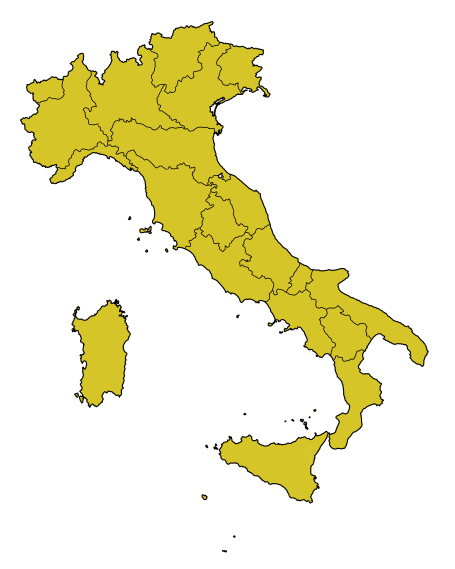

Most railway stations in Italy are maintained and operated by RFI, a subsidiary of Ferrovie dello Stato Group. A minor part of them are operated by private and regional companies, conceded by the state. [1] [2]
Stations by region
Lists of railway stations in Italy by region. [3]
Classification
RFI classifies stations into Platinum, Gold, Silver and Bronze categories. [4]
Platinum
Major stations with over 6,000 passengers per day. As major interchanges they will have many departures and arrivals daily, and will be served by high-speed/long-distance services. They are the principal stations for the Italian cities they serve. They have the highest commercial potential (both fares and revenue from on-site merchants). [5]
- Bari Centrale
- Bologna Centrale
- Firenze Santa Maria Novella
- Genova Piazza Principe
- Genova Brignole
- Milano Centrale
- Milano Porta Garibaldi
- Napoli Centrale
- Padova
- Palermo Centrale
- Pisa Centrale
- Roma Ostiense
- Roma Termini
- Roma Tiburtina
- Torino Porta Nuova
- Venezia Santa Lucia
- Venezia Mestre
- Verona Porta Nuova
Gold
Gold stations have high traffic levels. These include major urban inter-changes and stations serving large towns. They have a lower commercial potential.
Silver
This class includes all other small to medium-sized stations served by metropolitan and regional services. Some of these may be served by long-distance services.
Bronze
Small stations with low passenger numbers. This includes minor stations served by regional services.
Busiest stations
| Rank | Railway Station | Annual entries/exits (millions) | Number of platforms | City | Region |
|---|---|---|---|---|---|
| 1 | Roma Termini | 150 [6] | 32 | Rome | Lazio |
| 2 | Milano Centrale | 145 [7] | 24 | Milan | Lombardy |
| 3 | Torino Porta Nuova | 70 [8] | 20 | Turin | Piedmont |
| 4 | Firenze Santa Maria Novella | 59 [9] | 19 | Florence | Tuscany |
| 5 | Bologna Centrale | 58 [10] | 28 | Bologna | Emilia-Romagna |
| 6 | Roma Tiburtina | 51 [11] | 20 | Rome | Lazio |
| 7 | Napoli Centrale | 50 [12] | 25 | Naples | Campania |
| 8 | Milano Cadorna | 33.1 [13] | 10 | Milan | Lombardy |
| 9 | Venezia Mestre | 31 [14] | 13 | Venice | Veneto |
| 10 | Venezia Santa Lucia | 30 [14] | 16 | Venice | Veneto |
Operation
Grandi Stazioni is the commercial operator of 13 platinum-level railway stations. Centostazioni operates another 103 stations, including Milano Porta Garibaldi, Padova and Pisa Centrale. Both companies are owned by Ferrovie dello Stato.
See also
References
- ^ (in Italian) Article with a list of some Italian private railways
- ^ (in Italian) See also: it:Ferrovie in concessione
- ^ "Le stazioni oggi REGIONE per REGIONE". 2009 Network Statement. RFI. Archived from the original on 18 May 2011. Retrieved 25 July 2010.
- ^ "La classificazione delle stazioni ferroviarie" (in Italian). RFI. Archived from the original on 18 May 2011. Retrieved 17 February 2011.
- ^ Tratto da rfi.it Archived 2008-05-01 at the Wayback Machine URL consultato il 10-02-2008.
- ^ "Roma Termini - Roma Termini - Grandi Stazioni". Archived from the original on 2014-11-11. Retrieved 2019-11-27.
- ^ "Stazione di Milano Centrale - Info Stazione Milano Centrale - Tour Virtuale stazione | Milano Centrale". www.milanocentrale.it (in Italian). Archived from the original on 27 November 2019. Retrieved 29 April 2019.
- ^ "Torino Porta Nuova - Torino Porta Nuova - Grandi Stazioni". Archived from the original on 2011-06-15. Retrieved 2019-11-27.
- ^ "Firenze S. Maria Novella - Firenze S. Maria Novella - Grandi Stazioni".
- ^ "Bologna Centrale - Bologna Centrale - Grandi Stazioni". Archived from the original on 2012-02-10. Retrieved 2019-11-27.
- ^ "Roma Tiburtina - Roma Tiburtina - Grandi Stazioni". Archived from the original on 2015-03-17. Retrieved 2019-11-27.
- ^ "Napoli Centrale - Napoli Centrale - Grandi Stazioni". Archived from the original on 2017-08-08. Retrieved 2017-01-13.
- ^ Bilancio Sociale "LeNord" 2004-2005
- ^ a b "Venezia Mestre - Venezia Mestre - Grandi Stazioni". Archived from the original on 2018-09-08. Retrieved 2019-11-27.
External links
![]() Media related to
Railway stations in Italy at Wikimedia Commons
Media related to
Railway stations in Italy at Wikimedia Commons
